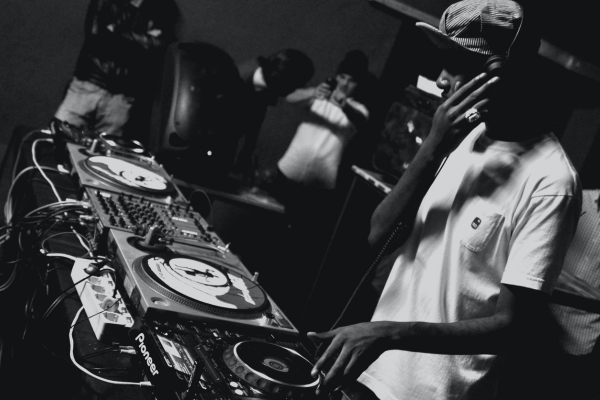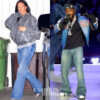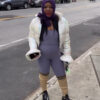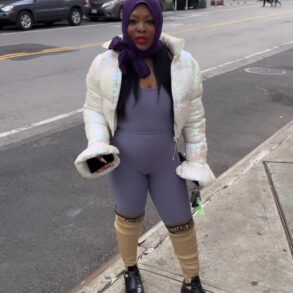
I’m not rushing to get there, but I often find myself wondering what heaven looks like. Creation is groaning. The world is not what God intends. Therefore, heaven has been heavy on my mind.
My version of heaven is laced with heavy basslines and driving drumbeats. When I imagine heaven, I see baggy pants and Jordans, suits and church hats, sweatpants and chinos. I smell gardens and ghettos, flowers and cinnamon. I see basketball courts, asphalt, and forests. I imagine the ground vibrating as people of every nation dance to an eternal beat. The heaven of my holy imagination is a hip-hop block party.
This year marks the 50th anniversary of the birth of hip-hop. From the rubble of gentrification and political abandonment in New York’s South Bronx, overlooked Black and brown kids used turntables and records to create new words and beats, movement and art. They built community and kinship, created meaning and culture, and developed self-worth in a world that hated them. “We were creating something that took up our time and made us feel good and brought us together,” Easy A.D., a member of Cold Crush Brothers, told oral historian Jonathan Abrams. “You have to imagine walking out your house every day and seeing abandoned cars burnt up, empty buildings, and you’re going to elementary school.”
Drawing on a rich tradition of African orality and the Black prophetic tradition, hip-hop provided social critique while giving people on the margins hope. Hip-hop culture proclaimed messages of joy, social awareness, cultural consciousness, resistance, activism, and community engagement. My college years are filled with memories of D-Nice warning us that we were headed toward self-destruction if we participated in the violence in the streets and Queen Latifah calling for people to respect Black women in “U.N.I.T.Y.” Prophetic messages dressed in dope beats painted apocalyptic block parties where everyone thrives. Hip-hop made space for imagining heaven on earth, right there in the ghettos of the South Bronx.
In his 1993 single, hip-hop artist Tupac Shakur asked: “I wonder if heaven got a ghetto.” For most folks, heaven is the opposite of a ghetto. Ghettos are often deemed places of poverty and violence, with little regard for the policies of oppression that have pushed people into these overlooked spaces.
Yet hip-hop made space for beauty in these ghettos. Young people used what was available and co-created a culture that now gives people of all colors space to live with dignity on their own terms. Imagine that: Life and beauty found unexpectedly in spaces reserved for death.
Jesus knew something about ghettos. His own hometown of Nazareth was a poor, forgotten place, often mocked for its reputation (see John 1:46). And it’s no coincidence, I think, that Jesus used his own victory over death to invite us into a new way living, meeting us where we are and giving us the ability to see beauty when we are expecting death.
But despite Jesus’ example, the church often prefers the safety and order of pristine buildings to unknown spaces that need some assistance. And while many churches do the needed work of addressing people’s immediate needs of food and clothing, churches less often challenge the systems that allow the world to continue to have ghettos in the first place. And even fewer take the time to recognize the beauty that already exists in these spaces. God is already in these spaces. The church must realize that sometimes our role is to meet God in these spaces.
Hip-hop culture, by contrast, has spoken life to young Black and brown people, providing space for generative and subversive expression of joy while participating in resistance and advocacy. For many people, hip-hop isn’t just music; it’s a movement that undergirds justice movements and knowledge building. Groups like the Hip Hop Caucus or the Center for Hip Hop Advocacy, and even my work with SojoAction use a hip-hop mindset to fight for social change.
I think the church must return to her roots of meeting people where they are and speaking life in places of death and destruction. And let’s remember: The church has adapted to new contextual realities before. I think of hush harbors in antebellum America, where enslaved people interpreted scripture on their own, trusting in a God who liberates. These were places of safety and joy in the face of physical bondage and emotional devastation — and became a precursor to the Black church. I think about how the early Methodist church encouraged whosoever will to come, growing throughout North America as they spread a simple proclamation of the gospel that was available to the literate and unliterate, the rich and the poor.
Or, in other words, the church needs to take a cue from hip-hop and return to the power of the remix, taking something that has been deemed old and worthless and reshaping it into spaces of beauty, hope, and thriving.
Of course, hip-hop, like the church, is by no means perfect. Both hip-hop and the church have been (rightly!) criticized for their violence, misogyny, and corruption. But what I see in hip-hop — and less often see in the church — is a willingness to honor the old while still being innovative. Hip-hop is turning 50 and there’s still room for both old hip-hop heads and Gen Z at the table. I see this innovation when new artists take a song that already exists and put a twist on it, adding a new beat, new lyrics, or even a guest artist. The remix takes something new and makes something new and fresh.
But in the church, older generations struggle to equip young leaders. And when the young folks are ready, these older generations often fail again by refusing to move out of the way. On the flipside, the young must embrace our history as they begin to lead. The church would do well to think about how different generations can coexist in leadership, remixing both old and new to create a beautiful new space that has room for both joy and resistance.
In this kind of church, when someone like Tupac takes the mic and asks if heaven has a ghetto, everyone says yes.
This post was originally published on this site be sure to check out more of their content.








